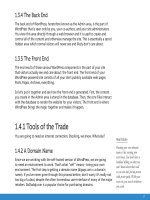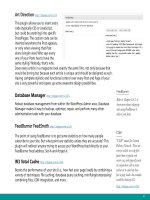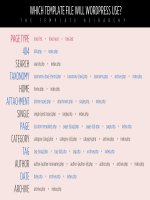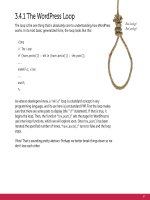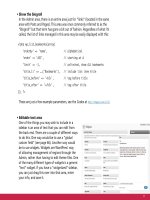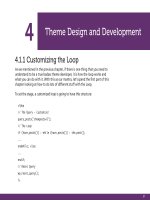Tìm Hiểu về Wordpress - part 22 potx
Bạn đang xem bản rút gọn của tài liệu. Xem và tải ngay bản đầy đủ của tài liệu tại đây (1.72 MB, 10 trang )
197
6.5.1 Tracking and Displaying
Feed Statistics
Once you get your feed established and properly configured, you will want to
begin offering it to your visitors. There are many ways to do this, including text
links, image links, and even FeedBurner badges that display the total number of
subscribers for your feed. Along with the number of subscribers for your site, the
free FeedBurner service also keeps track of many other types of statistical data.
From subscriber count and click-throughs to user reach and page hits, FeedBurner is
your one-stop resource for in-depth feed analysis.
6.5.2 Types of Statistics Provided by FeedBurner
As discussed above, FeedBurner provides some great tools for managing,
optimizing, and tracking your feeds. Here are some of the statistics provided
by FeedBurner:
• Subscribers counts – daily totals and chronological history
• Feed reader applications that are used to access your feed
• Uncommon uses, including re-syndication
• Reach – the unique number of people who view or click your feed content
• Item views – tracking of access to specied feed items
• Item link clicks optimized for complete item use or search engine ranking
• Item enclosure downloads, including podcast downloads
As you can see, FeedBurner tracks just about everything you may need to know
about your feed. Many of these statistics are included automatically with your
account, but others are “opt-in” and require you to activate them. Fortunately,
FeedBurner makes managing, using, and exporting your feed stats as pain-free
198
as possible, with everything fully accessible and configurable from within your
account’s Admin area.
6.5.3 Displaying FeedBurner Statistics
By far, one of the most popular uses of FeedBurner statistics is the public display
of a feed’s subscriber count. There are many ways to display your subscriber count,
including those little rectangular badges frequently seen in the sidebars of blogs
and sites around the Web. These free “chicklets,” as they’re called, are delivered by
FeedBurner and configurable via the FeedBurner Admin area.
Depending on your site’s design, however, you may prefer to display your
subscriber count in a way that better suits your specific design. Fortunately, there
are alternate, “text-only” ways of displaying your subscriber count, thereby
enabling you to display the number with the appropriate (X)HTML and CSS. Here
are two methods of displaying your subscriber count in plain text, enabling you to
markup and style the information in any way you wish and integrate it easily into
your design.
Method 1: Use PHP to display FeedBurner subscriber count
Using FeedBurner’s Awareness API and a bit of PHP, it is possible to display your
FeedBurner subscriber count as plain text. Here’s how to do it in three easy steps:
1. Open your sidebar.php theme file and add the following code to the location
where you would like to show off your subscriber count:
<?php
$feed = " />GetFeedData?uri=digwp";
$curl = curl_init();
curl_setopt($curl, CURLOPT_RETURNTRANSFER, 1);
FeedBurner Chicklets
You can choose animated and
non-animated chicklets, as well
as customize the colors used.
199
curl_setopt($curl, CURLOPT_URL, $feed);
$feed = curl_exec($curl);
curl_close($curl);
$xml = new SimpleXMLElement($feed);
$feedburner = $xml->feed->entry['circulation'];
echo $feedburner;
?>
2. Replace the term “digwp” in the first line with the username of your
FeedBurner account.
3. Done! Markup and style the plain-text subscriber-count output as desired and
enjoy the results.
Method 2: Use a plugin!
If you would rather just jump in and use a plugin to display your FeedBurner stats,
Francesco Mapelli’s excellent Feed Count plugin (see side note) does the job very
well. The plugin is a snap and provides all the functionality needed for customized
text-display of your subscriber count. With the plugin’s text output of your feed
stats, it is possible to echo virtually any message or markup you wish to embellish
your data.
6.5.4 Alternatives to FeedBurner
During the writing of this book, all FeedBurner accounts were transferred to
Google. During this process, an enormous percentage of FeedBurner users
experienced a sudden, drastic decrease in the number of reported subscribers.
This was very upsetting to say the least, and led many people to begin exploring
alternatives to the now-questionable FeedBurner service.
“Are there any alternatives to FeedBurner?” We encounter this question
Feed Count Plugin
Unfortunately, at the time of
this writing, the Feed Count
web page was marked as an
“attack site.” So, until the
author resolves the issue, we
have made the plugin available
through our site at this URL:
/>To the Streets!
The FeedBurner problems
made a lot of folks angry
and was documented by
TechCrunch here:
/>200
As awesome as it is, the Feed Count plugin can’t work when
the FeedBurner data is unavailable. Despite its best intentions,
FeedBurner occasionally returns inaccurate data for the
subscriber count. For those of us who care about the accuracy of
our publicly displayed feed statistics, displaying information like
this on your site is simply unacceptable:
Join N/A awesome subscribers!
…or perhaps even worse:
Join 0 awesome subscribers!
Ugh. Clearly not the way to leave a good impression and
encourage visitors to subscribe to your feed. Fortunately, we
have an excellent fallback mechanism to ensure that all visitors
see the correct subscriber information. Begin by placing the
following script in your active theme’s functions.php file:
<?php
function feedcount_fallback() {
if(function_exists('fc_feedcount')) {
ob_start();
fc_feedcount();
$count = ob_get_contents();
ob_end_clean();
if($count == 'N/A' || $count == '0') {
echo 'many other';
} else {
echo $count;
}
} else {
echo 'many other';
}
}
?>
Once that code is in place, replace the default Feed Count
function call with this in your theme’s template file:
<p>Join <?php if (function_exists('feedcount_fallback'))
feedcount_fallback(); ?> awesome subscribers!</p>
Once in place, that code will output one of the following
messages, depending on availability of accurate FeedBurner
subscriber-count data:
When the subscriber count is correct:
“Join 243 awesome subscribers!”
And when the subscriber count is either “N/A” or “0”:
“Join many other awesome subscribers!”
How does this script work? Basically, we are using PHP’s output
buffering functionality to capture the output value of the
fc_feedcount() function and compare it to the two possible
error values (“N/A” and “0”).
When the error values are detected, the alternate, fallback
message is displayed; otherwise, the function displays the
correct count value.
Plus, as an added bonus, the function covers your bases by
outputting the fallback message in the event that the Feed
Count plugin itself should fail. This method ensures proper
subscriber count display without relying on the availability
of JavaScript, the accuracy of FeedBurner data, or even the
functionality of the Feed Count plugin!
More information at Perishable Press: />Prevent FeedBurner Errors with a Fallback Mechanism
201
repeatedly every time FeedBurner drops the ball. Until recently, FeedBurner was
pretty much it for delivering feeds and keeping track of statistics. This is one of the
reasons why just about everybody is using FeedBurner – the competition has been
scarce. Fortunately, some promising FeedBurner Alternatives are finally gaining
some traction:
• FeedBlitz
FeedBlitz has been around as long as I can remember and should have been in
the feed-delivery/tracking game from the beginning. Even so, better late than
never with their new RSS delivery service.
• RapidFeeds
RapidFeeds publishes and monitors your RSS feeds for free. Looks relatively new
but very promising.
• FeedStats
FeedStats is designed to track the total number of people who are subscribing
to your various feeds. The total number of subscribers takes into account
different feed formats, such as RDF, RSS, and Atom.
• Feed Statistics
In addition to tracking your daily subscriber count, the Feed Statistics plugin
also monitors and reports information about which feed readers are being
used to access your feeds, as well as data on Post Views, Top Feeds, and Click-
throughs – all within the convenience of the WordPress Admin.
6.6.1 Customizing Feeds
Once your feed is up and running, there are many ways to customize its
appearance and functionality. If you are using FeedBurner, there are many
different ways to style and present the feed to your visitors. Yet even without
FeedBurner, there are many great ways to improve the appearance and
functionality of your WordPress feeds. Let’s take a look at some popular and
useful modifications.
202
It is a classic CSS sin to use inline styling. It completely defeats
the purpose of using CSS, which is to separate content from
design. If we wanted to call special attention to a box on the
page, it would be smart for us to do something like:
<div class="callout">
content
</div>
When we publish our content with RSS as WordPress does,
people won’t be viewing our content on our website, but in
whatever they use to read RSS content. This could literally be
anywhere, but a classic example would be a reader reading
through Google Reader. In the Google Reader environment,
our special class of “callout” has no meaning whatsoever. On
our own website, callout might mean it has some extra padding
and a yellow background, but in Google Reader, it will have no
effect at all.
If we want to make that extra padding and yellow background
come through over RSS, we can force it by using inline styling.
<div style="padding: 15px; background: #fff3c4;
margin: 0 0 10px 0;">
content
</div>
Just remember that inline styling is generally regarded as evil
for a reason… if you ever needed to change the styling, you’d
have to go back into every single Post that used it, instead of
being able to just change the CSS for “callout.”
Inline Stylin’ for RSS
Inline styling in the Post
Result in RSS reader
203
6.6.2 Formatting Feed Images
Images, as in <img src" " alt=" " /> elements, are by default
“inline” elements. That means despite them having a width and a
height, they don’t break lines and kind of just go with the flow of
the text around it.
In your theme, the CSS might be taking charge and changing this
default inline behavior. It is possible that images are set to block
level elements in your stylesheet, which forces line breaks before
and after them. Or the images could have special classes applied to
them which float them left or right so text wraps around them. But
unfortunately, your CSS doesn’t mean anything when the Post is
being read through an RSS reader. Those images will revert to their
old inline-level selves.
One classic way of avoiding this problem is making sure you have
an extra line break above and below the image tag when creating/
editing your Post. Here is a screenshot demonstrating this technique:
The nicely oated image in this TechCrunch article
reverts to a non-oated inline image in the RSS feed
and is rather awkward.
The empty lines above will ensure that the top paragraph, image, and
bottom paragraph will all be automatically wrapped in <p> tags without
implicitly using them.
204
One of the (slightly weird and confusing) things that WordPress does is
automatically apply <br /> tags into posts where a single return was used, and
automatically apply wrapping <p></p> tags to blocks of content separated by
double line-breaks.
The end result is that this image tag separated from other content by double line-
breaks on either side will now be wrapped in paragraph tags, which are by default
block-level elements. This effectively makes your image a block level element, and
will prevent any weird text wrapping.
Another option is to use inline styling on the images, for example:
<img src=" " alt=" " style="oat: left; margin: 0 10px 2px 0;" />
This will be effective on the site and through the RSS feed, with the major
shortcoming that should you ever need to update this styling you’ll have to return
to this post and manually alter it (rather than a sweepingly simple CSS change).
6.6.3 Adding a Custom Feed Image
Out of the box, WordPress feeds are very plain. Apart from any images that your
posts or comments may include, your WordPress feeds appear without any logos
or branding images. A great way to enhance your site’s brand is to add a custom
image to your feeds. Here’s how to do it:
1. Add the following code to your theme’s functions.php file:
function mwp_feedImage() {
echo "<image>
<title>Digging into WordPress</title>
<url> /> <link> /> <width>150</width>
205
<height>150</height>
<description>Digging into WordPress</description>
</image>";
}
add_action('rss2_head', 'mwp_feedImage');
2. Edit each of the different XML elements to reflect your site’s information.
3. That’s it! Save, upload and check out your new custom-branded RSS feed!
Add custom image to Atom feed
For Atom feeds, the process is very similar:
1. Add this code to your functions.php:
function mwp_atomImage() {
echo "
<icon> /> <logo> /> ";
}
add_action('rss2_head', 'mwp_atomImage');
2. Edit each of the different XML elements to reflect your site’s information.
3. All done! Save, upload, and check out your new custom-branded Atom feed!
Alternately, FeedBurner users may add a feed image to any of their feeds by using
the “Feed Image Burner” feature available in their account admin area.
Branding is Key
Presenting a strong brand identity
is a key part of your site’s success.
Customizing your feeds with your logo is
an excellent branding opportunity.
206
6.6.4 Include Comments in Feeds
While WordPress excludes post comments from feeds by default, certain sites may
benefit from including them. The easiest way to do so is to mashup a quick feed
pipe at the free Yahoo! Pipes service Sounds complicated, but
it’s really simple. Here’s how to do it in ten easy steps:
1. Sign into Yahoo! Pipes with your Yahoo! ID.
2. From the “Sources” menu in the left sidebar, drag an instance of the “Fetch
Feed” badge to the working area.
Merging Feeds
As seen in this section, Yahoo!
Pipes is an excellent way to
merge multiple feeds into a
single feed, but it’s not the only
mashup service that does so.
Another good service is RSS
Mix, which you can check out
at />


